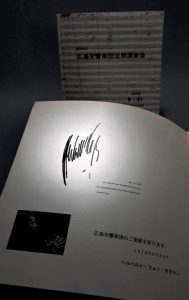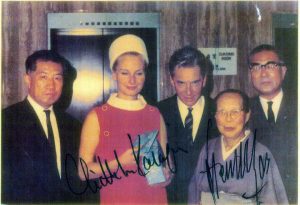Story of Hiroshima Symphony Orchestra’s 50 years since turning pro, Part 1 (5): A photo and encouraging message from Herbert von Karajan
Feb. 19, 2022
Music-loving brothers shared hope for establishment of Hiroshima orchestra
by Aya Nishimura, Staff Writer
Herbert von Karajan (1908–1989), the most famous music conductor of the 20th century, once penned a message of encouragement for the Hiroshima Symphony Orchestra (HSO) when the group was still made up of amateur musicians. Mr. Karajan’s message appeared in a brochure advertising the orchestra’s 14th regular concert, held in 1970. At the beginning of the brochure is printed Mr. Karajan’s message, which reads, “My best wishes for the prosperity of the Hiroshima Symphony Orchestra,” written in both Japanese and German, along with his autograph and a photograph of his face. Why did the ‘king’ of classical music send the message to the local orchestra in Hiroshima before it turned professional? Members of the orchestra’s administrative staff, when asked, were unaware of the background behind the message. While seeking clues to solve the mystery, this writer discovered a certain photograph.
The photo is displayed in an office at the Ohashi Shokai, Co., a distributor of building materials located in the commercial hub Shoko Center, in Hiroshima’s Nishi Ward. It shows Toshio Ohashi, former president of the company who died in 1973 at the age of 73, together with Mr. Karajan and his wife, among others. Shinobu Ohashi, 86, Toshio’s oldest son, recalled the time the photo was taken. “My father called me on the phone and asked me to come immediately with my camera,” he said, adding that the photo was taken when the Berlin Philharmonic orchestra had been in Hiroshima for a concert held in the city in April 1966.
Starting before World War II, Toshio Ohashi was known as a collector of vinyl record albums of classical music. After the war ended, he provided commentary for record-based concerts and also was active as a music critic. For the Chugoku Shimbun in December 1964, he wrote an article expressing his expectations for the orchestra that got its start in Hiroshima. “I can’t help but wish this group, founded by citizens in Hiroshima, can grow into a wonderful orchestra along the lines of the City of Kyoto Symphony Orchestra or the Gunma Symphony Orchestra,” he wrote.
However, HSO’s path from an amateur orchestra consisting of unpaid musicians to a professional group was filled with difficulties. Starting in 1965, the orchestra began to receive a small amount of funding from the Hiroshima City government. But paying monthly salaries to a large number of orchestra members and maintaining the orchestra’s management offices would require a huge amount of money. Tomin Harada, the HSO chairman at the time, traveled repeatedly to Tokyo to seek support from the national government. It was difficult, however, to convince the government to fund the orchestra of little renown. At that time, Mr. Ohashi served as the orchestra’s vice chair.
In 1971, Japan’s Agency for Cultural Affairs launched a plan to support HSO, which began to receive funding from both Japan’s national government and the Hiroshima Prefectural government. Such monetary support forged the way for the orchestra to turn professional the following year, 1972, after the Hiroshima Symphony Orchestra Association was established.
Further back, Mr. Karajan’s message appeared in the orchestra’s concert brochure in 1970. The unexpected message from the conductor not only pleased Hiroshima’s people but might also have provided momentum to the orchestra in its effort to turn pro. At the time, Mr. Karajan was even well known among members of the general public who were not familiar with classical music, and his Berlin Philharmonic’s national tour was broadcast on radio and television. When Mr. Karajan visited Hiroshima for the first time, he is said to have closed his eyes and stood silently in front of the A-bomb Dome for more than 10 minutes.
The person thought to have come up with the idea of the surprise message was ultimately discovered. He was the other man in the photo with Mr. Karajan and Mr. Ohashi. The man’s name is Nobuo Fukuhara, Mr. Ohashi’s younger brother who served as the NHK (Japan Broadcasting Corporation) music director. Mr. Fukuhara accompanied Mr. Karajan on his orchestra’s concert tour in Japan and maintained close contact with him over many years. It is no wonder then that he voluntarily played, for the orchestra, the role of mediator between HSO and Mr. Karajan.
Mr. Ohashi and Mr. Fukuhara were born into the Ohashi family, which operated a wholesale building materials business in the area of Kawaramachi (now part of Hiroshima’s Naka Ward). Later, however, when still a child, Mr. Fukuhara was adopted by another family. On August 6, 1945, the Ohashi company was destroyed in the atomic bombing, given that it was located only 1.2 kilometers from the hypocenter. Mr. Ohashi’s older brother, who had taken over the family business, was killed in the bombing. Mr. Ohashi was safe, however, due to his visit to the Hiroshima suburbs the previous day. After the war, he devoted himself completely to the restoration of his family’s business.
The son Shinobu still remembers a scene he witnessed when he was an elementary school student during the war. While his father Toshio was enjoying listening to records with his musical acquaintances, four or five military police officers barged into their house and reprimanded the gathering. “It’s shameful to listen to the enemy’s music,” they exhorted. Although his father explained that the music was composed in Germany, an ally of Japan, the officers did not relent, hitting him again and again. The image was branded into Shinobu’s memory.
Shinobu said, “To my father, music genuinely meant peace. He desperately wanted to have an orchestra based in Hiroshima.” Mr. Fukuhara also found hope in music in his hometown after the war. In a Chugoku Shimbun column titled “Chronicle,” published on December 15, 1982, he wrote, “Whenever Beethoven’s Ninth Symphony was played (at a music café in the city’s black market), it was full of customers. In the dark city still struggling with wounds from the atomic bombing, people full of hope for recovery attentively listened to music.”
HSO was born from the scorched ruins and has been supported by the passion of the public. With its beautiful harmonies, the orchestra is passing on that passion to the future.
End of Part 1
Keywords
Nobuo Fukuhara
Born in Hiroshima in 1918. After graduating from the First Hiroshima Prefectural Junior High School (now Kokutaiji High School), Mr. Fukuhara graduated from Waseda University and the Conservatory of Music (now Tokyo College of Music). Joined NHK in 1941. After his mandatory retirement from NHK in 1974, he worked as a music critic and served as professor and president at the Tokyo College of Music. Mr. Fukuhara died in March 1988.
(Originally published on February 19, 2022)









